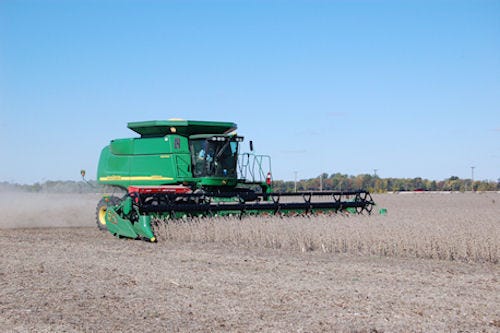April 6, 2014
Whoever said there are no new ideas under the sun may have a point. One person recently wondered why you couldn't spread cover crop seed off the grain head as you combined. You can, and it's covered by the residue coming out the back of the machine. You can also seed it off a corn head. Ray McCormick has proven that both work.
McCormick, Vincennes, first devised a way to mount a seeder on his corn head so he can seed a cover crop as he harvests. Stalk residue falls over the seed.
Slick operation: Ray McCormick completed his second season of seeding cover crop off his soybean head this past fall.
Two years ago, he mounted a Gandy orbital seeder on the grain platform of his combine. Through trial and error he figured out how to get the seed to blow through tubes to cover the width of the head. What he gains is that the residue spread evenly by the combine falls on the seed, protecting it. He also has his cover crop seeded as soon as the crop is harvested.
What McCormick wonders is why Gandy has not promoted the idea so other farmers know it's possible. As far as he knows, they don't provide a kit for this option.
Related: High-Clearance Cover Crop Seeding In Infancy
In some operations, labor is a limiting issue – it's difficult to have someone else to run the drill or a broadcast seeder after harvest is over. Some people have mounted a seeder onto a vertical tillage tool if they have someone to run an extra tractor. Ideally, they like to have the vertical tillage tool and seeder running while the combine is still working in the same field or another field. The whole goal is to get the cover crop mixture seeded to give it the best chance of emerging and getting enough fall growth to make it through the winter.

Ray McCormick combining soybeans with Gandy cover crop seeder (red box) attached to grain heat. He and his son rigged it up themselves.
Radishes and turnips don't over winter, but they still need to be planted early enough to get fall growth that will produce roots deep enough to help break up soil compaction. Other cover crops, such as oats, don't overwinter. The benefit they provide comes from fall growth.
Thinking about a cover crop? Start with developing a plan. Download the FREE Cover Crops: Best Management Practices report today, and get the information you need to tailor a cover crop program to your needs.
You May Also Like




